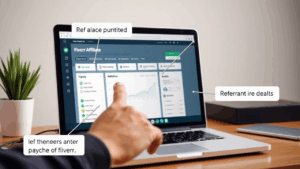This case study is a customer in a very competitive finance category which means that it is in the business of credit cards, insurance policies, SBA loans, credit card processing, etc… They are not a large brand but directly compete with them.
The site had a good presence but with every core update dropped slightly. They approached us to determine whether we could change the trend around and because we began in November 2024 we’ve been doing just that.
The below case study takes you through how we diagnosed the website and what steps we’re actively working on to get it growing. Like with other case studies I’ll continue to update the screenshots with time as well as share learnings while keeping them as our SEO company. Like with the other SEO case studies that I’ve done for the last four or five years, we’re doing absolutely zero link building.
Backlinks are essential, but they do not matter nearly as much as they once did. If you publish quality content and can help ensure that it does not sound like and mirror AI and LLMs, folks begin to offer you backlinks naturally. These are the precious ones that drive content, product pages, categories/collections, and service pages.
Let’s dive right into the screenshots and then the step-by-step traffic recovery and growth process.
Screenshots
These are the initial screenshots when I first wanted to publish in late February 2025.
Here in this first screenshot you can see things were looking good, there’s growth starting after plateauing and dropping traffic. A 16 month time frame illustrates a steady drop. We were able to start reversing this.
In the screenshot above from search console you can see that refreshing the content is bringing life to what was either stale, in need of proper sourcing and citations, or written for SEO purposes rather than for the user. But we aren’t done yet.
In this third screenshot you’ll notice other pages are still declining and some lost all of their traffic entirely. There are occasions when in a recovery traffic is less or the same, but that is not the indication that you are declining. The initial few months appear flat, but we observed new traffic and high-intent traffic entering while older content kept declining. The outcome was even traffic balance that reflected no net-gain as the declines were now equal to the incoming traffic. Other times the layout of the search result change, so even if you’re in the top three positions, traffic decreases because of AI Overviews, more PPC ads, and rich results like forums and people also ask.
We’re continuing to implement more tech SEO changes and increase the quality of the content as we’re seeing the results and patterns we’re hoping for.
Update March 2025
I’m sitting down to write this case study on the last day of March 2025, so it’s been a month since I captured the first screenshots and thought why not do an update to demonstrate progress with apples to apples. Below is how the site is going.
New and redesigned content with some additional of the tech changes is paying off. We currently have roughly five months’ worth of changes to learn from so we can see what is and isn’t working. We’re taking these insights and applying them to the older pages that are still declining. The advantage now is that we have control groups and data to support our choices. This allows us to have an easier time knowing what to alter and how to prioritize next.
There isn’t any shortage of things we’d like to do, the data informs us in what order we must do them. We can prioritize this into the content team’s backlog and prioritize it with the IT team by launch and so we don’t contribute to the technical debt that nearly every company has.
So far we’ve added over 1 million impressions over the past three months YOY and increased website traffic. This includes the lead gen pages that drive revenue for the company and is measurable. So far its a big win all around and we’re excited to keep going.
The Steps to Recover the Finance Client’s SEO
To have traffic rebound we did five primary things following the SEO audit in the first month:
- Rebuild some of the template so it is following best practices
- Find and refresh evergreen and seasonal content
- Repair sources and citations
- Refresh internal links
- New content and add whistles and bells
Rebuild the Template
The template was not terrible, but it was not doing all the things that we wanted it to do. For instance H tags were being utilized to layout elements on a page rather than to tell us what the subject of the content in a section is. There were some unnecessary scripts that did not need to be on the site, and a couple of rendering issues that had to be addressed.
Negotiations were already underway for a redesign, or half redo, so we thought why not. Several teams such as our SEO, PPC, and content teams were all in agreement so the planets were aligned. Nothing major or dramatic was done, but we did reworked some of the URLs and site organization, recoded the templates themselves according to SEO and other best practices, and we seized the moment to include some calls to action where we had pre-sold users on why they should believe in the brand.
Find and Update Content That Requires It
And, as with all sites that are established for any amount of time, there isn’t a lack of content with outdated info, skimpy copy, stuff done out of love for old teammates that doesn’t make sense now, non-evergreen material to clean up on, etc… So we developed a game plan.
- Discover evergreen content with or which previously had traffic
- Find seasonal topics that will be popular in 3 or 4 months to see whether or not we can recapture that traffic
- Work with non-evergreen topics and articles
- Search for entity based topics that are uncovered or aren’t covered adequately
- Do a GAP analysis and see what the competition appears for or writes about that we don’t or haven’t
- See what’s trending, popular, or users are inquiring in forums and communities, and incorporate them into our blend
The initial step in content review was easy, look for pages that previously had traffic or conversions and don’t anymore, or pages losing positions for relevant keywords. You can do this in search console by looking at a 3 or 6 month comparison YOY, click on pages, and order by loss in clicks. If you use a different tool like quicksite, looker, etc… you can possibly look further back.
We discovered content that lost traffic but generated revenue and established a plant to regain it. This begins by examining what was lacking or not well-formatted in the content and planning how to enhance it. Some of it was just reformatting the content to make it easier to digest like flipping paragraphs into bullet points or tables, and others it was removing whole sections of content because they were only being put there for SEO and not to support the subject.
Then we searched for what people search for seasonally and picked out subjects that needed to be reworked for the current season. If it is holiday season shopping, we refreshed the content in late Q2 or early Q3 so that it can rank during the critical time. For tax content we refresh in late Q3 or early Q4. Refreshing ahead of the season allows you to track how the changes affect rankings before you need the content to perform.
As we did this we searched for content that should have been evergreen but is not. Making it evergreen, or removing it if it has no value to new users and customers is generally always a good decision. If the non-evergreen is present for a reason and can be backlinked because of its historical value, keep it and save it in an archive.
Last we knew that we still need to post new content to begin creating new business and build readership. We did not think about keywords, we thought about what would benefit our users and added topics that we hadn’t touched yet. Similar to what we’ve seen elsewhere, writing content for a user versus an SEO keyword can lead to traffic. This is part of entities in SEO.
We browsed through forums and employed research tools to conduct a content GAP analysis. From there we examined what entities have search volume and produced content to satisfy the user need. For others we ensured the subjects would assist the end user in making a decision, and these can potentially get into Google discover or receive backlinks and social shares. By doing this we were able to begin ranking for keywords in a competitive niche, even when we don’t use the keywords in the headers, etc…
Fix Sources and Citations
This is one of those small things that doesn’t move the needle on its own, but does build user confidence. When added to other small things can shift the needle




